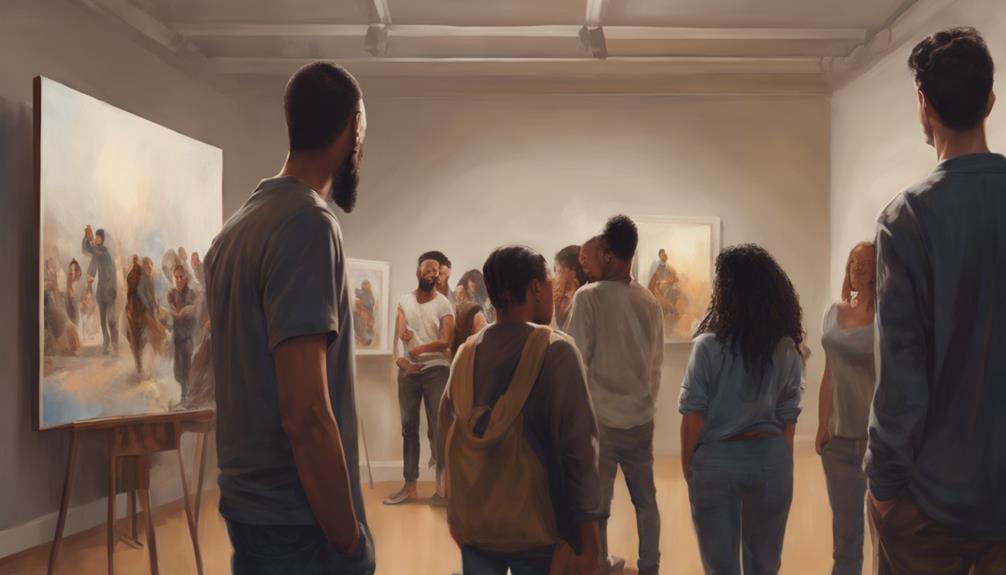The interplay between personal experiences and the interpretation of art is a multifaceted and intriguing subject. Our unique backgrounds, memories, and emotional responses serve as the foundation upon which we build our understanding and appreciation of artistic expressions. By examining how our individual narratives intersect with the artwork we encounter, we can uncover a deeper connection to the pieces that resonate with us on a personal level. This intersection of personal history and artistic interpretation opens up a world of exploration into the intricate ways in which our experiences shape the lens through which we perceive art.
Key Takeaways
- Personal narratives enrich emotional connections with art.
- Cultural influences impact interpretation and appreciation of artwork.
- Artists draw inspiration from personal experiences for authentic creations.
- Understanding personal context enhances the depth of art appreciation and connection.
Understanding Personal Narratives in Art
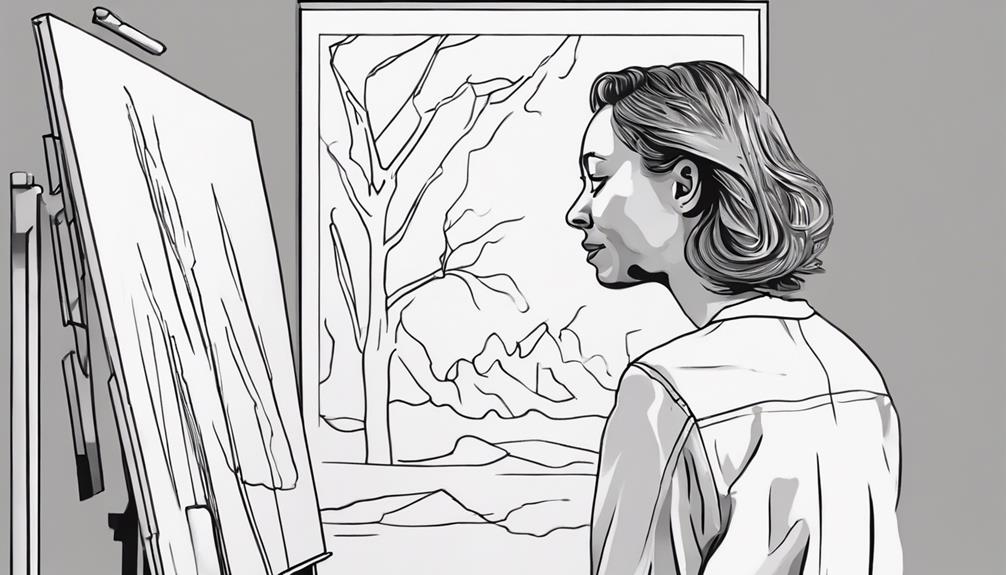
Through the exploration of personal narratives in art, one can discern the profound impact of individual experiences on the emotional and intellectual connections formed with artistic creations. Artists draw inspiration from their personal experiences, whether they be traumas, joys, cultural backgrounds, or significant life events. These personal encounters often serve as the driving force behind the creation of art, infusing pieces with authentic emotions and deep meanings that resonate with both the creator and the audience.
The process of making art becomes a channel through which artists can express their innermost thoughts, feelings, and experiences, allowing viewers to engage with the artwork on a more profound level. The emotional resonance found in art created from personal narratives transcends mere aesthetics, touching the core of human emotions and experiences. When viewers understand the personal context from which art emerges, they gain valuable insights into the artist's intentions, leading to a deeper appreciation and connection with the artwork.
The Influence of Life Experiences
How do life experiences shape the artistic expressions of renowned creators throughout history? Personal experiences play a vital role in influencing the art created by artists, leading to a diverse range of styles and themes. The table below illustrates how different life experiences have impacted the artistic expressions of various artists:
| Artist | Artistic Style | Life Experiences |
|---|---|---|
| Edvard Munch | Symbolism, Expressionism | Personal struggles and emotional turmoil |
| Pablo Picasso | Cubism, Blue Period | Inner conflicts and societal changes |
| Odilon Redon | Symbolism, Surrealism | Inner experiences and imaginative visions |
| Henri Matisse | Fauvism, Modernism | Health challenges and vibrant interpretations |
| Linda S. Watson | Contemporary, Mixed Media | Natural disasters and environmental influences |
These examples demonstrate how life experiences, whether personal struggles, societal changes, or health challenges, have been pivotal in shaping the artistic styles and themes of various artists throughout history. By delving into their own experiences, artists have been able to create profound and impactful works of art that resonate with audiences on a deep emotional level.
Personal Reflections on Art Interpretation
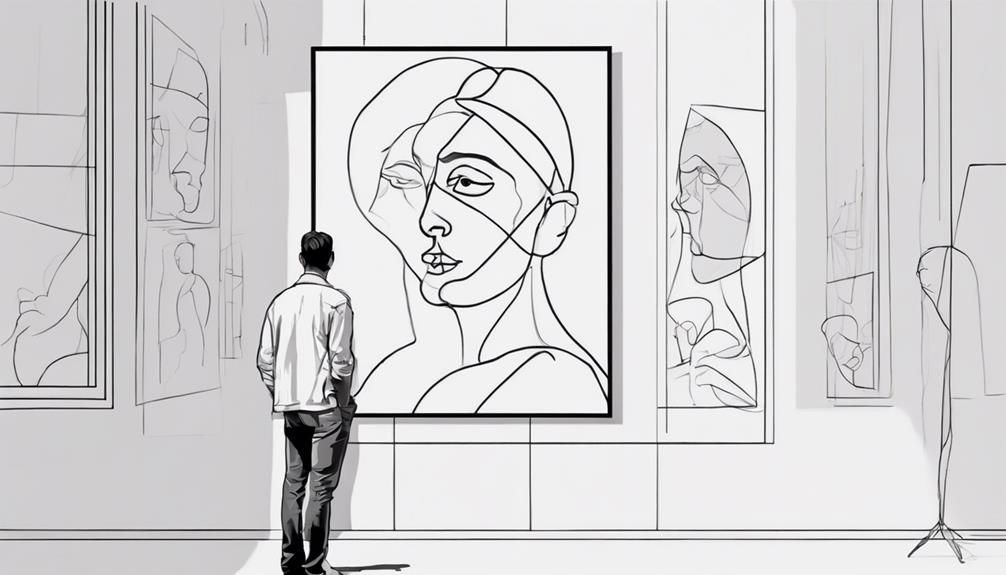
The personal reflections individuals have when interpreting art play a crucial role in shaping their emotional connections to the artwork. These reflections are influenced by a myriad of factors, including memories, cultural background, and life events, which all contribute to the unique responses individuals have towards art. By examining how personal experiences influence art interpretation, we can gain a deeper understanding of the intricate relationship between the viewer and the artwork.
Influence of Experiences
Experiences such as trauma, travel, and spiritual awakenings play a pivotal role in shaping individuals' interpretations and connections with art. Artists often draw from personal encounters to create contemporary art that resonates with others. For instance, a single person's traumatic experience may inspire an artist to delve into themes of resilience or recovery, reflecting a universal human experience. To illustrate further, traveling to different regions exposes artists to diverse cultures and landscapes, influencing their choice of colors, subjects, and techniques. Additionally, spiritual awakenings can lead artists to explore inner emotions and translate them into visual expressions that evoke profound feelings in viewers. Therefore, personal experiences act as catalysts for artistic innovation and enrich the interpretation of art.
| Trauma | Inspires themes of resilience and recovery |
|---|---|
| Travel | Influences choice of colors, subjects, and styles |
| Spiritual Awakening | Translates inner emotions into visual expressions |
| Cultural Encounters | Provides new perspectives for artistic creations |
| Personal Challenges | Shapes artistic expression and thematic elements |
Emotional Connections
Art interpretation is intricately intertwined with emotional connections that individuals form based on their personal reflections. When engaging with art, viewers often draw from their memories, life events, and cultural background to establish a profound emotional bond with the artwork. Modern art, especially in limited edition pieces, can evoke diverse emotional responses, resonating uniquely with each observer. The emotional impact of art is heightened when viewers find elements in the artwork that mirror their own experiences or beliefs, fostering a deeper connection. Understanding the artist's intent and context behind the piece can further enrich these emotional connections, allowing individuals to appreciate and interpret the artwork on a more profound level.
Exploring Art Through Personal Lens
Through the intricate interplay of personal histories and cultural contexts, individuals navigate the realm of art with a unique perspective that shapes their interpretation and appreciation of artistic expressions. This personalized lens through which art is viewed is influenced by a combination of personal narratives, emotional connections, and cultural influences.
- Personal Narratives: Each individual brings their own life story, experiences, and memories to the table when engaging with art. These personal narratives act as a filter through which the art is perceived, allowing for a deeply subjective and individualized interpretation.
- Emotional Connections: Emotions play a significant role in how art is experienced. Past traumas, joys, and personal struggles can evoke strong emotional responses to artistic expressions, creating a profound connection between the viewer and the artwork.
- Cultural Influences: Cultural backgrounds and societal norms also shape how individuals interact with art. These influences provide a framework for understanding artistic styles, themes, and symbols, contributing to a richer and more nuanced appreciation of art.
Impact of Individual Experiences in Art
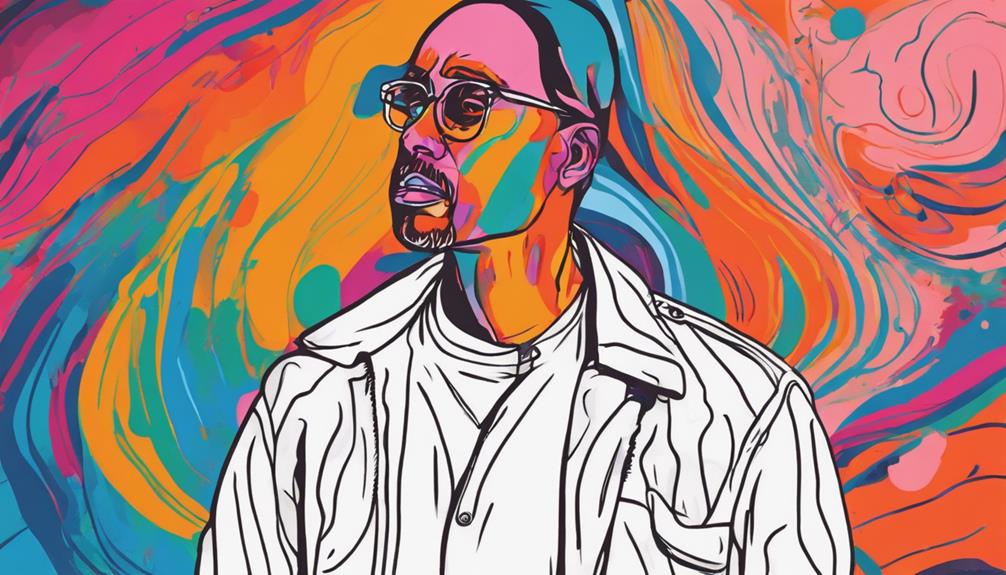
In the realm of artistic interpretation, the impact of individual experiences emerges as a pivotal factor shaping the emotional resonance and depth of engagement with artwork. Personal narratives, shaped by memories, cultural background, and beliefs, play a significant role in how individuals perceive and connect with artistic expression. Life events and encounters can trigger specific emotional responses to art, thereby altering one's perception and appreciation of it. These individual perspectives contribute to the diverse range of reactions that art can evoke, highlighting the subjective nature of artistic interpretation. Understanding the artist's personal journey can further enrich one's connection to their work, providing insight into the creative inspiration behind the art. Emotional connections to art are often deeply influenced by personal experiences, while cultural influences can also play a crucial role in shaping how individuals interpret and relate to different forms of artistic expression.
Interplay of Personal Stories and Art
The interplay between personal stories and art is a complex phenomenon that involves the intertwining of individual narratives, emotional connections, and cultural influences. Personal narratives embedded within art pieces can evoke strong emotional responses and resonate with viewers on a deeply personal level. Moreover, the cultural background of both the artist and the viewer plays a significant role in shaping the interpretation and reception of art.
Personal Narratives in Art
Personal narratives intertwined with art illuminate the profound connection between artists' lived experiences and the creative essence embodied in their work.
Key Points:
- Artistic inspiration: Artists draw from personal stories, emotions, and memories to infuse their creations with depth and significance.
- Emotional resonance: The narratives behind artworks offer insight into the artist's perspective, allowing viewers to connect emotionally with the piece.
- Personal storytelling: Understanding the personal narratives behind art pieces enhances appreciation and deepens the viewer's intellectual and emotional engagement with the artwork.
Emotional Connections With Art
Expanding beyond mere visual appreciation, emotional connections with art are intricately woven through the interplay of personal narratives and artistic expressions. Artistic empathy plays a significant role in fostering these connections, enabling viewers to resonate with the emotions conveyed in the artwork. Personal storytelling, communicated through the visual language of art, allows individuals to relate their own experiences to the pieces they encounter. This process leads to subjective interpretations, where viewers infuse the artwork with their emotions and memories, enriching the overall artistic experience. Artists often embed their personal journeys into their creations, evoking profound emotional resonance in the audience. Understanding the intertwining of personal narratives and artistic expression enriches the appreciation and significance of art in the eyes of the beholder.
Cultural Influences on Art
Cultural influences intricately shape the interpretation and appreciation of art by intertwining personal stories with broader societal contexts.
3 Ways Cultural Influences Impact Art Appreciation:
- Shaping Personal Narratives: Cultural influences mold our personal narratives, guiding how we perceive and express ourselves through art.
- Influencing Artistic Expression: Cultural backgrounds impact artistic styles, themes, and techniques, contributing to the diversity and richness of artistic expression.
- Enhancing Art Interpretation: Emotional connections to art are deepened through cultural influences, providing a multifaceted lens through which individuals interpret and connect with artistic creations.
How Experiences Shape Art Perception
Experiences play a fundamental role in shaping individuals' perception and interpretation of art. Through personal narratives, individuals bring their unique backgrounds and emotions to their artistic perspective, influencing how they connect with and understand artworks. The emotional resonance of art is heightened when viewers can relate their own experiences to the themes and messages portrayed in a piece. Artists themselves often infuse their creations with elements from their personal histories, be it major life events, trauma, or moments of significance, making their work a reflection of their own journey. Additionally, art can serve as a therapeutic outlet for both creators and viewers, allowing them to express and process their experiences in a creative and meaningful way. This process of intertwining personal experiences with art not only enriches the viewer's understanding but also adds layers of depth and complexity to the artwork itself. Ultimately, diverse backgrounds, cultures, and memories contribute to the varied interpretations and responses individuals have towards art.
Personal Histories and Art Appreciation
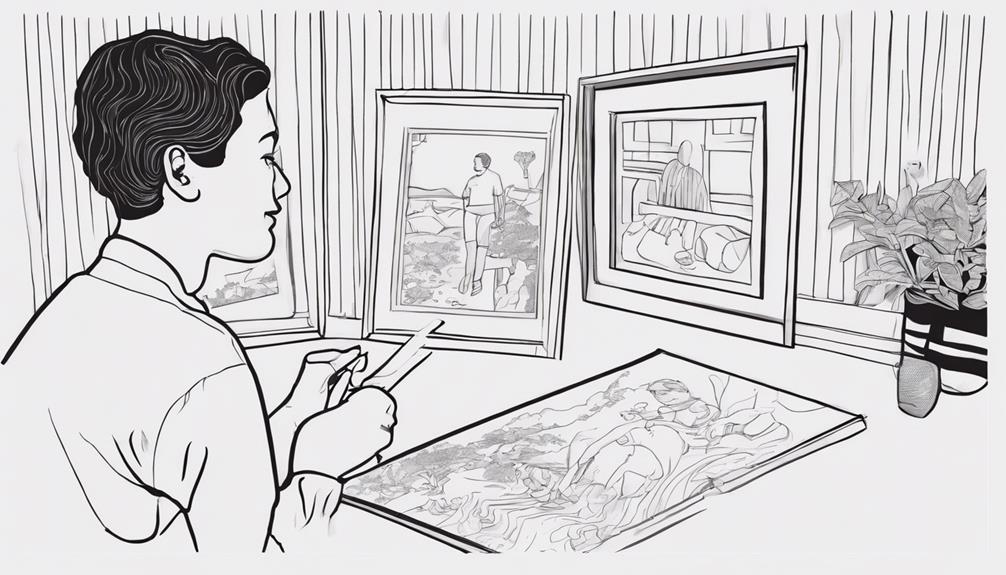
The correlation between individuals' personal histories and their capacity to appreciate art is a nuanced aspect that significantly influences their interpretation of artistic expressions. When considering the intersection of personal stories and artistic influences, several key points emerge:
- Individual Perspectives and Emotional Responses: Personal histories, including memories and emotions, play a crucial role in shaping how individuals perceive and connect with art. These unique perspectives can evoke varied emotional responses, leading to a more profound appreciation of the artwork.
- Cultural Background and Upbringing: One's cultural background and upbringing contribute to the lens through which art is viewed. These factors influence the interpretation of artworks, adding layers of meaning and significance based on personal experiences.
- Life Events and Artistic Interpretations: Varied life events, such as triumphs, losses, or significant milestones, can impact how individuals interpret art. These experiences inform artistic interpretations, allowing for a deeper connection to the artwork based on personal narratives.
Artistic Interpretation Through Personal Experiences
Artistic interpretation through personal experiences delves into the emotional aspects of art, highlighting how memories and feelings shape individual perceptions. Emotions in art often stem from an artist's personal encounters, infusing their creations with layers of significance that resonate with viewers. Additionally, an artist's cultural background can profoundly impact the themes and messages conveyed in their work, offering a lens through which to understand the context of their artistry.
Emotions in Art
Emotions in art serve as conduits through which individuals navigate and interpret the intricate tapestry of visual narratives, drawing upon their unique personal perspectives to imbue artworks with layers of subjective meaning and significance.
- Emotional responses in art are influenced by personal experiences, cultural background, and memories.
- Personal narratives play a crucial role in shaping how individuals connect emotionally with artistic expressions.
- Artistic expressions often reflect the emotions and experiences of the artist, inviting viewers to engage with the artwork on a deeper, more personal level.
These factors combine to create a rich tapestry of emotional connections between the viewer and the artwork, making each interpretation unique and deeply personal.
Memories Influence Interpretation
Memories play a pivotal role in shaping the interpretation of art, intertwining past experiences with present perceptions to create a unique and personalized understanding of artistic expressions. Memory triggers associated with specific artworks can evoke emotional resonance, enhancing the viewing experience by adding layers of personal significance. Through personal narratives, individuals bring their own histories and emotions to the art they encounter, allowing for a deeper connection and appreciation. This interplay between memories and art interpretation underscores the subjective nature of perception, emphasizing how individual experiences can profoundly impact one's aesthetic understanding. Nostalgia, empathy, and introspection are just a few of the emotions that can be stirred when viewing art through the lens of personal memories, highlighting the intricate relationship between memory and artistic interpretation.
Cultural Background Impact
Cultural heritage significantly shapes individuals' perspectives on and engagement with artistic expressions, fostering a unique framework through which art is understood and appreciated.
3 Key Points:
- Cultural perspectives, artistic expression: One's cultural background influences how art is perceived, providing a lens through which artistic creations are interpreted and valued.
- Personal narratives, creative interpretation: Personal stories and experiences rooted in cultural heritage contribute to the creative interpretation of art, shaping individuals' connections with various artistic forms.
- Emotional connections, cultural influences: Emotional responses to art are intertwined with cultural influences, with past experiences and traditions playing a significant role in forming deep connections with artworks.
The Role of Memories in Art Engagement
The significance of personal recollections in influencing individuals' connections with and interpretations of art is a crucial aspect to consider when examining the role of memories in art engagement. Memories play a pivotal role in shaping our emotional responses to art, as personal experiences stored in memories influence how we connect with and interpret artistic pieces. These memory triggers can evoke specific emotions or associations when encountering art, enriching our understanding and creating emotional resonance with the artwork. The recollection of past experiences through art leads to a more personal and subjective interpretation, allowing individuals to craft their own personal narratives based on their memories.
| Memory Triggers | Emotional Resonance |
|---|---|
| Personal experiences evoked by art | Deep emotional connection |
| Associations linked to memories | Enhanced understanding |
| Personal Narratives | Art Engagement |
| Crafting subjective interpretations | Deeper connection with the artwork |
| Linking memories to artistic experiences | Enhanced personal engagement |
Emotional Connections to Artistic Expression
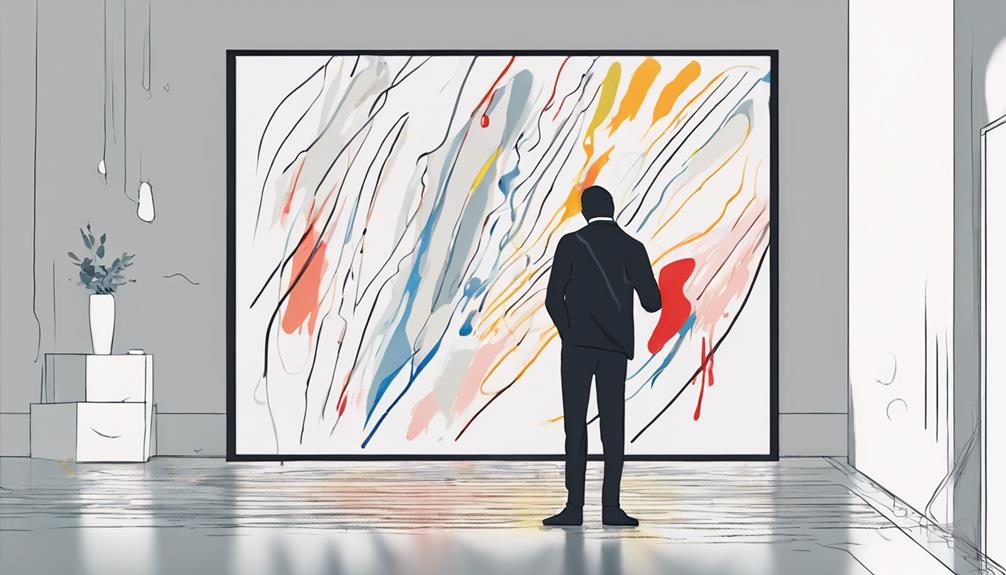
Drawing upon personal experiences, individuals establish profound emotional connections with artistic expression, significantly influencing their interpretations and resonance with art. This emotional resonance plays a crucial role in how viewers connect with artworks on a deeper level. Here are three key aspects to consider in the context of emotional connections to artistic expression:
- Personal Storytelling: The narratives and emotions embedded in art often mirror the personal stories of both the creator and the observer. Viewers may find parallels between their own experiences and those depicted in the artwork, fostering a sense of connection and empathy.
- Artistic Expression: Artists use their creations as a medium to express their innermost thoughts, feelings, and experiences. Viewers, in turn, interact with these expressions, interpreting and internalizing the emotions conveyed through the artwork.
- Interpretation and Resonance: The subjective nature of art allows individuals to interpret and resonate with pieces in unique ways based on their personal experiences. This diversity of emotional responses adds richness and depth to the viewer's engagement with artistic expression.
Art as a Reflection of Personal Journey
Art as a Reflection of Personal Journey can be understood as a profound intersection between an artist's life experiences and the expressive medium of art itself. Artists often undergo a journey of self-discovery and personal growth through their creative process, shaping their artistic evolution. This emotional resonance within the artist translates into their artistic expression, making art a mirror of their inner world. Viewers, when aware of the personal context behind the artwork, can connect more deeply with the piece, appreciating the layers of meaning embedded within. By recognizing the artist's narrative woven into the artwork, viewers engage in a richer interpretation that goes beyond surface-level appreciation. The table below summarizes the key aspects of how art reflects personal journeys:
| Keywords | Description |
|---|---|
| Artistic Evolution | Reflects the artist's growth and development over time. |
| Personal Growth | Demonstrates how personal experiences shape the artist's creative journey. |
| Creative Process | Illustrates the transformative nature of creating art as a means of self-discovery. |
| Self Discovery | Art serves as a tool for artists to explore and understand themselves on a deeper level. |
| Emotional Resonance | The emotional depth and significance embedded in the artwork, reflecting personal experiences. |
Frequently Asked Questions
How Do Life Experiences Influence the Way We Relate to Art?
When examining how life experiences influence our relationship with art, emotional connections and cultural influences play pivotal roles. Memory associations and sensory perceptions also significantly impact our interpretation of artwork. Psychological responses and social backgrounds further shape our understanding and appreciation of art. By acknowledging these factors, we can better comprehend the intricate ways in which personal experiences inform our engagement with artistic expressions, enriching our overall connection to the creative world.
How Does Art Connect to Personal Experiences?
Art connects personal experiences through emotional connections, subjective perceptions, and personal narratives. Artists infuse their work with personal meaning, drawing inspiration from life events. Viewers bring their own memories and cultural backgrounds to their visual interpretations. This interplay between artistic expressions and individual experiences creates a rich tapestry of meaning and interpretation in the realm of art.
How Might Your Personal Context Impact How You Interpret Artworks?
Personal context, including cultural backgrounds, emotional responses, memories, societal influences, personal values, and aesthetic preferences, significantly impact how individuals interpret artworks. These factors shape one's lens through which art is perceived, influencing the emotional connection, understanding, and appreciation of artistic pieces. By considering personal context, viewers can uncover deeper meanings, establish unique interpretations, and engage with art on a more profound and subjective level.
Why Does an Artist Need to Have Personal Experience in Art?
An artist's personal experiences are vital for fostering creative inspiration, establishing emotional connections, and nurturing personal growth within their artistic vision. Through lived experiences, artists can infuse their work with authenticity, depth, and unique perspectives. These encounters shape an artist's artistic style, influencing their choice of subjects, themes, and techniques. Ultimately, personal experiences serve as a wellspring of inspiration, driving artists to create meaningful and impactful art that resonates with viewers on a profound level.
Conclusion
In conclusion, personal experiences play a crucial role in shaping our interpretation of art, adding layers of complexity and personal meaning to the artistic experience. While some may argue that art should be interpreted objectively, it is important to recognize that individual experiences act as a lens through which we view and appreciate art. By understanding the influence of personal narratives, we can better appreciate the emotional connections and reflections that art brings to our lives.
